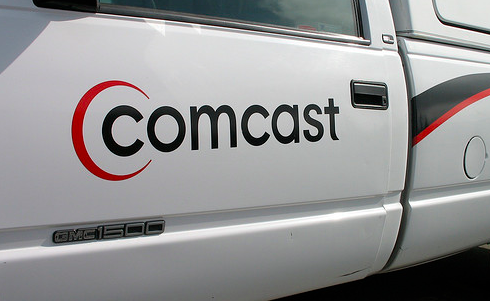How Comcast Uses Low-Income Families To Look Good For Regulators

(spidra)
It’s not the first time that Comcast has waved the flag of its commitment to underserved populations right as regulators were poised to take a fine-toothed comb to its business dealings. Internet Essentials is now here to stay — but who does it really serve?
The Internet Essentials program is aimed at helping a niche that badly needs help.
Let’s say this up front, and clearly: expanding broadband access to lower-income households is a laudable and deeply necessary goal. In 2014, internet access is basically how everyone does everything. Need to apply for a job? Do it online. Need to access state and federal services? Do it online. Need to contact a school, do your homework, research something? Do it online.
Internet access isn’t just about the newest in entertainment (though it is that, too). It’s access to jobs, to education, to commerce, to news and information, to friends and family, and basically to the entire world at large. Being locked out of it due to high prices can be crippling in a hundred little ways, especially to a family with children who may be falling academically and socially behind their more moneyed peers.
The gap of the digital divide is real, and it’s persistent. The Pew Internet Project has tracked internet access for years. On average, 85% of Americans access the internet. But an average is just that: averaged. Breaking down the data by household income, on the other hand, highlights the disparity.

Broadband internet access by income, via The Pew Internet Project.
Pew’s research, from last fall, shows just how big that divide is, and the correlation is undeniable: the more money you make, the more likely you are to have broadband internet access.
Given how expensive a utility broadband can be, it’s not surprising that workers hanging onto the lowest rung of the economic latter have trouble buying into it. But as digital tools become more and more prevalent in the classroom, kids who aren’t well-versed in them are at a distinct disadvantage for catching up to their classmates.
So with Internet Essentials, Comcast really is trying to fill in service for a segment of the population that generally goes underserved. 300,000 families are using the service, according to Comcast’s most recent progress report, and that’s 300,000 families who weren’t connected before.
That’s the good news. Now here’s the rest.
There aren’t as many families benefiting from Internet Essentials as there could be.
While it’s great that over a quarter million families have enrolled, it could be a lot more. But somehow, Comcast just keeps managing to stand in its own way.
There are two major obstacles to getting low-income families enrolled in the program, according to outreach workers. The first is is the set of eligibility requirements Comcast lays out. To enroll in Internet essentials, families must:
- Be located where Comcast offers Internet service
- Have at least one child eligible to participate in the National School Lunch Program
- Have not subscribed to Comcast Internet service within the last 90 days
- Not have an overdue Comcast bill or unreturned equipment
Of those four requirements, that 90-day requirement is apparently the biggest stumbling block. Families who were overextending themselves to pay for a full-price Comcast package have to go completely without all service for three full months in order to reduce their costs. 90 days is a full semester of the school year — a long time for a family to cut itself off.
The other barrier is the enrollment process itself: Internet Essentials is separate from Comcast’s standard service. It uses a different website and phone number for enrollment and information. Consumers who call Comcast’s regular line and try to ask for the cheap internet generally get shunted into some kind of promotional triple-play package. Comcast representatives don’t redirect callers to the other phone number.
So the consumers most likely to be able correctly to sign up for Internet Essentials are high-information consumers who have the time and resources to use the internet to research how to get the best choice in internet access. And the target user of Internet Essentials is a lower-information consumer, potentially with education and/or language barriers, who doesn’t necessarily have the time and resources, or internet access, to do all the research over best choices.
It’s not just the enrollment that has a mismatch between “service on offer” and “needs that need filling.” Comcast has been touting their partnership with Khan Academy as a way to provide more free online education to low-income families… and while that sounds nice, the truth is, low-income kids aren’t the ones really using streaming online courses. College-educated men are.
Comcast benefits far more than low-income families do.
The other main problem with Internet Essentials is that it’s crap. A download speed of “up to 5 Mbps” is, by the standards of 2014, painfully slow. Those fancy online educational tools that are supposedly the main benefit of the program? Many of them don’t work so well on that connection.
In other words, Comcast is giving their low-income customers access to what they pay for — not access on par with what most other Comcast customers can buy. It’s both a fifth of the cost and a fifth of the service.
The focus on families with children eligible for free or reduced lunch is also a big problem with the program. Pew found that “internet non-users are heavily dominated by older adults.” No kids at home? No connection.
And what about when those kids grow up? Eligibility is directly tied to having children in the home. When Junior, thanks to his reduced-rate Comcast connection, graduates from high school and gets a full scholarship to State U, will Mom and Pop back home still be able to get e-mails from him? Slate wondered about that in a piece questioning Comcast’s motives back in January. Comcast exec David L. Cohen immediately fired back with a complete non-answer:
“As to the issue of families losing access when kids graduate, the piece ignores our commitment to continue to offer Internet Essentials to any family so long as there is a single eligible child in the household.”
And as to the issue of families losing access when kids graduate, the executive ignores families’ commitment to not producing infinite children, and eventually having a youngest who turns 18 and graduates, thus ending the parents’ eligibility.
Comcast, meanwhile, is not acting out of a sense of charity or philanthropy. They’re satisfting federal requirements to help bring broadband access to the poor. And Internet Essentials is only available where Comcast already operates — so Comcast isn’t spending a dime to run infrastructure to any place where it doesn’t already exist.
They sure get to benefit from looking philanthropic, though. Community outreach is a huge part of Comcast’s extensive lobbying efforts. And in looking to gain the blessing of federal regulators on their impending buyout of Time Warner Cable, “benefit to the community” is one of their best cards to play.
If Comcast succeeds in buying out TWC, they can argue, then that means they can expand the Internet Essentials program to 19 of the 20 biggest cities in the country. Since broadband access is a huge factor in the merger, Comcast wins from being able to claim that expanding their reach equals reducing the digital divide. If the poor and underserved get to benefit just as much as executives do well the merger must be a good idea, right? Right?!
And of course, every added customer for Comcast is, well, another customer for Comcast. Although actual provider choice and competition are terrible for everyone, options can be even more limited for lower-income families. It’s not just for reasons of cost; it’s because they’re generally renters, not property owners. Renters in multi-unit buildings generally have exactly one choice for TV and internet access: the company their landlord has signed a contract with.
Having Internet Essentials gives Comcast the leverage to go to a community and say, “we have this low-income program; sign more contracts with us so we can help disadvantaged families in your area.” And cities do. More reach, more leverage, less competition: a win all around for Comcast.
So is it just window-dressing?
Just because Comcast gets to win all around, of course, doesn’t mean low-income families have to lose. A terrible internet connection is still better than no internet connection, and over a quarter million families probably are better off now than they were before. That’s not a bad thing.
But as often happens with Comcast, the good news they’re selling isn’t the whole story. When it comes to the digital divide, and to fairly serving the underserved, there’s a long way yet to go.
Want more consumer news? Visit our parent organization, Consumer Reports, for the latest on scams, recalls, and other consumer issues.

